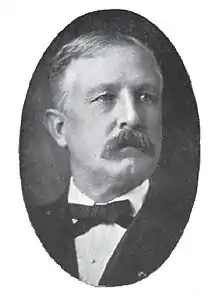John J. Hawkins
John Jay Hawkins (January 4, 1855 – May 1, 1935) was an American jurist and politician who served as Associate Justices of the Supreme Court of Arizona Territory and as a member of the Arizona Territorial Legislature.
John Jay Hawkins | |
|---|---|
 | |
| Associate Justice, Arizona Territorial Supreme Court | |
| In office April 1893 – July 21, 1897 | |
| Nominated by | Grover Cleveland |
| Preceded by | Edmund W. Wells |
| Succeeded by | Richard Elihu Sloan |
| Personal details | |
| Born | January 4, 1855 Saline County, Missouri |
| Died | May 1, 1935 (aged 80) Los Angeles, California |
| Political party | Democratic |
| Spouse(s) | Olive Birch |
| Profession | Attorney |
Biography
Hawkins was born in Saline County, Missouri to George Scott and Francis Marion (Gauldin) Hawkins on January 4, 1855.[1] He was educated in public schools before enrolling at William Jewell College and the University of Missouri.[2] Upon completion of education in 1877, Hawkins began reading law under Glasgow, Missouri attorney Thomas Shackelford.[3] He was admitted to the Missouri bar in 1878 and practiced law with Shackelford for the next five years.[4]
In 1883, Hawkins moved to Prescott, Arizona Territory.[2] He was made probate judge for Yavapai County in 1885.[3] That same year he formed a legal practice with J. C. Herndon which lasted until 1893.[2] On May 5, 1855, Hawkins married Olive Birch of Glasgow, Missouri.[4] The marriage produced one daughter.[3]
Hawkins was appointed Territorial Auditor in 1887. The Democratic Hawkins held the position till March 1889 when he was replaced by an incoming Republican governor. In 1892, Hawkins was elected to represent Yavapai County on the Council of the 17th Arizona Territorial Legislature.[3]
President Grover Cleveland nominated Hawkins to replace Edmund W. Wells in Arizona's fourth judicial district in April 1893. During his time on the bench, procedural issues were common.[3] Two examples of his rulings in such manners are Thomas v. Lane, 4 Arizona 156 (1894), where the judge rules that when counsel claims an error in a case they should also specify what they believed the error to be and United States v. Falshaw, 4 Arizona 330 (1895), when he ruled the United States was required to pay witness expenses on behalf of indigent defendants.[5] At the end of his four-year term, Hawkins was not reappointed and was succeeded by Richard Elihu Sloan on July 21, 1897.[3]
Following his time on the bench, Hawkins returned to his private legal practice.[6] In addition to his legal career he was an active member of the Episcopal Church, serving once as Chancellor of the denomination's territorial mission board and two times as a Lay Delegate to the General Convention.[4] Hawkins was also a member of Prescott's Masonic Lodge.[2]
Hawkins served as President of the territorial bar association from 1900 till 1901.[6] In 1904 he was a delegate to Universal Congress of Lawyers and Jurists.[2] Following Arizona gaining statehood, in 1914, Hawkins ran for one of three open seats on the Arizona Supreme Court but failed to gain one with his fourth-place finish. The following year he taught mining law at the University of Oklahoma College of Law.[6]
Hawkings retired to Los Angeles, California in 1916.[6] He lived there till his death on May 1, 1935.[2] Hawkins was buried in Glendale, California's Forest Lawn Memorial Park.[6]
References
- Goff 1975, pp. 146-7.
- "Judge Hawkins Dead on Coast". Prescott Evening Courier. May 2, 1935. pp. 1, 8.
- Goff 1975, p. 147.
- Conners 1913, p. 164.
- Goff 1975, pp. 147-8.
- Goff 1975, p. 149.
- Conners, Jo, ed. (1913). Who's who in Arizona. Vol I. Tucson: Arizona Daily Star. OCLC 8862523.CS1 maint: ref=harv (link)
- Goff, John S. (1975). Arizona Territorial Officials Volume I: The Supreme Court Justices 1863-1912. Cave Creek, Arizona: Black Mountain Press. OCLC 1622668.CS1 maint: ref=harv (link)